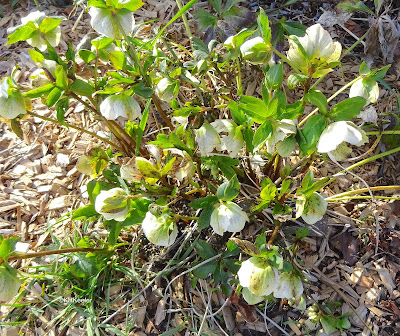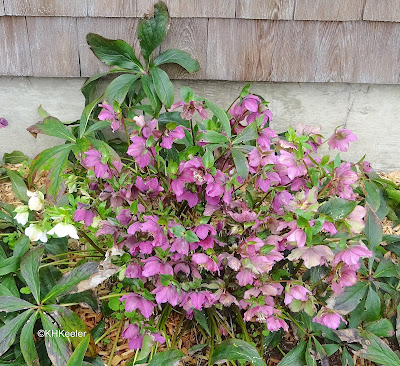 |
| Lenten rose, Helleborus |
 |
| Lenten rose, Helleborus |
Helleborus is a small genus of about 20 Eurasian flowers, in the buttercup family, Ranunculaceae.
All parts are poisonous. Handling of plants can dermatitis, and cases of poisoning from just contact have been reported. Ingestion causes burning of mouth and throat, and often excess saliva, nausea and cramps, vomiting, and diarrhea. Hellebore poisoning can be fatal. In its native Eurasia, this toxicity was probably important for plant survival since it emerges and flowers at the beginning of spring, when grazers are hungry and not many plants are available. The toxins also work in North America, causing deer and rabbits to avoid them.
Hellebore has been used as a medicine in Europe for millennia, usually as a purge. The diarrhea and vomiting were considered cleansing, for melancholy as well as the body. In addition, salves with hellebore treated skin conditions including gangrene, pieces were put into the ear to improve hearing, and it reputedly helped leprosy, jaudice, gout, sciatica and convulsions. (Most of this according to Culpeper, 1654). It was widely used to treat women's complaints, such as amenorrhea. It is sufficiently toxic that there was a high mortality rate; get the dose right it was a potent medicine, use too much and the patient died.
Hellebore is famous for its use in biological warfare. This was in ancient Greece during the First Sacred War, also called the Cirraen War, about 590 BCE. An army from Thessaly and its allies Scion and Athens (called the Amphictyonic League), attempted to wrest the Sacred Land of Apollo, the Kirrhaean Plain, from the city of Kirrha, at least in part because the Kirrhans were harrassing pilgrims going to Delphi. Beseiging Kirrha, the allied armies discovered a water pipe leading into the city and added hellebore (Helleborus niger). The contaminated water produced diarrhea throughout Kirrha, so they could not resist the assault. Having taken the city, the attackers killed everyone and destroyed the city. The rough outline of the story is held to be valid, there is lots of controversy over the details.
Despite this kind of story, hellebore appears only in some of my "poisonous plants" books. In some places it is a common garden flower, so that omission is curious.
 |
| Lenten rose, Helleborus |
In the milder areas of Eurasia, hellebores flower in winter and will be in flower at Christmas. That is an uncommon pattern and the flowers are lovely so they were called the Christmas flower or Christmas rose. In colder areas, the plant is of necessity dormant at Christmas but emerges early and so is called the Lenten rose, making it again a beloved flower because so little is flowering when it does.
The Christmas flower name is explained by the story of Madelon, a shepherd girl, who came to Bethlehem on the night that Christ was born. Awestruck, she wished for a gift but had note. Standing outside, looking in, she started to cry. God, looking down, sent an angel, who turned each tear, as it landed on the frozen ground, into the small white flowers of hellebores. The angel told Madelon that devotion was more precious gold. Madelon gratefully picked a bouquet and laid it by the manger. And that was the origin of the Christmas rose.
 |
Helleborus was the Greek name, which combines bora (food) with helein (injures or destroys), warning that the plant is toxic. Linnaeus turned the Greek name into the scientific name. The species epithet, niger, means black and refers to the color of the root, which was used medicinally. Heleborus niger is from the mountains of Europe. Also commonly planted is Helleborus viridis (older name H. orientalis) from Turkey and the Caucuses; viridis means green, as the flowers are. Many cultivated hellebores are hybrids.
Common names for these plants, in addition to hellebore, Christmas rose, and Lenten rose, include setter-wort and setter-grass, boar's foot, and bear's foot. Setter in this use is from Old German and the Oxford English dictionary does not know its origin. Boar's foot and bear's foot probably describe the look of the big deeply divided leaves when the plant isn't flowering. \European herbalists sometimes called hellebores melampodes, based on the Greek story that the physician and seer Melampus cured the insanity of the three daughters of Proetus of Argos with it.
This is a beautiful flower. Treat it with respect. Wear your garden gloves and don't nibble it. Watch for it in the early spring.
Comments and corrections welcome.
Sources, General
Creekmore, H. 1966. Daffodils are Dangerous. The Poisonous Plants in Your Garden. Walker and Company, Publishers. New York.
Culpeper, N. orig. originally 1653. Culpeper's Complete Herbal. W. Foulsham Press. London.
Grieve, M. 1931. A Modern Herbal. Dover, New York.
Major, A. 2019. Chemical and biological warfare in Antiquity. pp. 8-20 in P. Wexler, ed. Toxicology in Antiquity II. in History of Toxicology and Environmental Health. Academic Press. New York. link (accessed 3/4/23)
Missouri Botanical Garden. Helleborus niger. Missouri Plant Finder. link (accessed 23/2/23)
Vasileiou, V., Markantes,G.K., Armeni,A.K., Barouti,K., Georgopoulou,A. and N.A. Georgopoulos. 2017. Melampus and the cure of Proetus’ daughters. Hormones. 16(2): 212-216. link (accessed 3/5/23).
Sources, Madelon and the Christmas rose
Leo S. 2020. #4. The legend of Madelon and the Christmas rose. Random Times. (blog; Dec. 4, 2020) link (accessed 3/53/23)
Martin, L.C. 1987. Garden Flower Folklore. The Globe Pequot Press, Chester, Connecticut.
Ztevetevans. 2013. The legend of Madelon and the Christmas rose. Under the Influence (blog) link (accessed 3/5/23).
and others; I pulled all kinds of references for this post.
Post about the two hellebores, Helleborus and Veratrum link
Post on the other hellebore, Veratrum link
Kathy Keeler, A Wandering Botanist
More at awanderingbotanist.com
Join me on Facebook: https://www.facebook.com/AWanderingBotanist



No comments:
Post a Comment